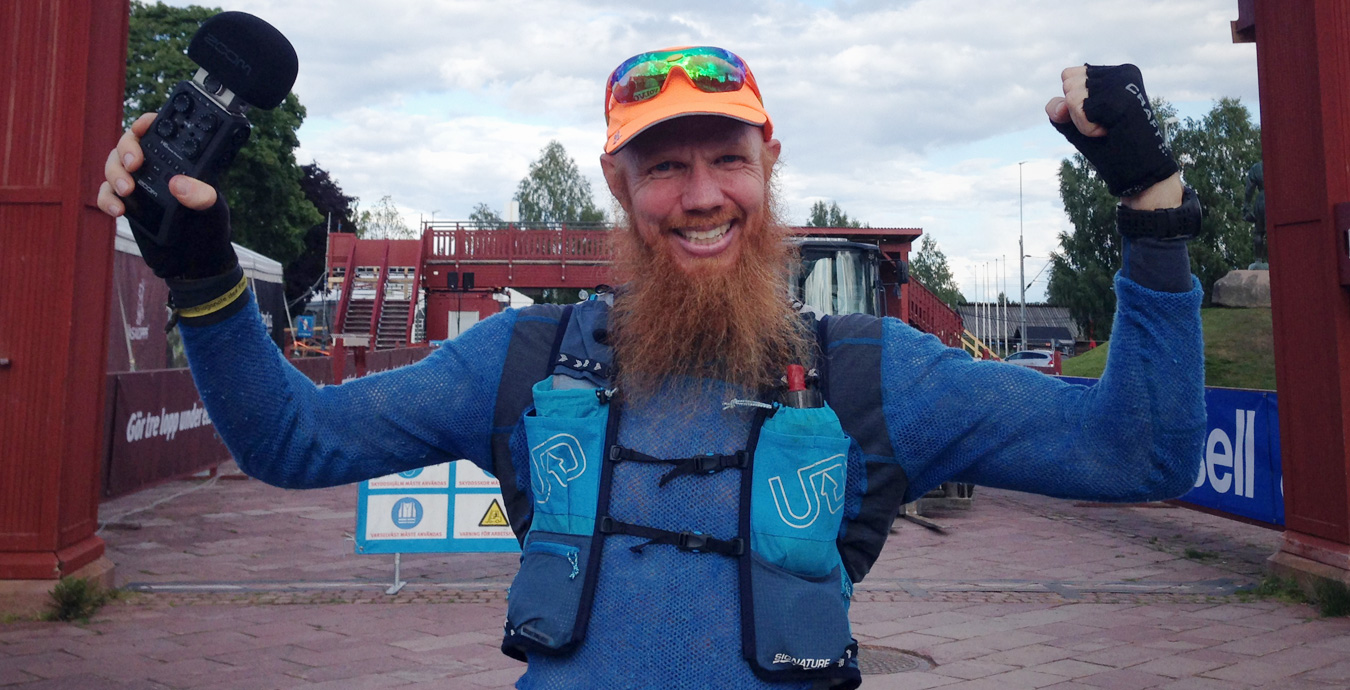How to tackle Ultravasan 45 and Ultravasan 90 in August
Are you registered for Ultravasan 90 or Ultravasan 45? Or are you considering signing up? Long distances can feel a bit scary but our official Vasaloppet coach Johnny Hällneby doesn't think there's anything to be afraid of.
”The biggest challenge is actually daring to slow down,” he says.
Johnny Hällneby is a well-known name in ultrarunning circles, both via his own competition results and the podcast Pace on Earth. In recent years, he’s been an expert commentator on Vasaloppet.TV.
Here are Johnny’s answers to questions about ultrarunning, though many of these tips are equally helpful to those taking aim at Trailvasan 30 or Trailvasan 10.
Five questions – five answers:
When preparing for Ultravasan 90 or Ultravasan 45 this spring, what should I focus my training on?
”Dream of your upcoming race and look forward to the challenge! When you focus on that positive energy, you’ll find a natural sense of continuity. And finding continuity in your training (training often!) is much more important than the number of hours per week you spend running. It’s also more important to train every week and nailing that regularity over time, rather than hitting a certain number of training sessions per week. Many people think they need to train a lot more than they actually do. I usually say that those who manage to run 30 km while training have good chances of being able to run 90 km in a competition. Ultrarunning is about the mental aspect and getting the right energy into you; it’s not about training super hard all spring. Try to get some long workouts where you take it easy, and practice eating.”
Is there any must-have equipment?
”Not really, but there are some things that make the journey a little nicer. You can run Ultravasan 90 and Ultravasan 45 in any running shoes but I recommend trail running shoes. It can be smart to use a running backpack or running vest. You can replenish your energy at the checkpoints but carrying your own refreshments means that you can top up with something small now and then when you need it. The same goes for liquids. It’s nice to be able to drink smaller amounts from time to time, rather than having to drink loads all at once at a checkpoint. And a running backpack or vest gives you space to carry an extra jacket which can make your journey more comfortable if you have to walk for a while.”
What are the most common beginner mistakes?
”Setting off too fast at the start and not eating and drinking enough. Many people run too fast during the first third of the race and wait too long to replenish their energy, because the start is easy. This behaviour almost always punishes itself.
”It’s important to keep track of how much energy you need to consume to run long distances; usually it’s more than you think. And it is also important to start eating early in the race, preferably after 45–60 minutes. In terms of speed, my tip is to try to find a pace that you can keep all the way to the finish line, or even a pace where you’re saving energy and can increase your speed towards the end. For many, it’s a huge challenge, daring to run so slowly at the start of the race.”
How should an ultrarunner train to maintain their physique in the long term and avoid injuries?
”Run slowly. Running injuries usually occur in connection with high intensity training. Tough interval workouts aren’t needed to build endurance for the slightly lower ”ultra tempo” so training before an ultrarunning race should be more gentle. Especially if you train in the woods, running on soft and varied surfaces. It’s also great to occasionally train your agility as well as your functional strength, but you don’t need much to get a good effect. 10–15 minutes of mobility and strength training a few times a week makes a big difference in avoiding injuries. The most important thing, however, is that you practice running calmly and for long periods of time.”
Your best tip to make the workout more fun?
”Does training have to be fun every time? I think that’s overrated. Think instead that running should be meaningful and fulfil a purpose. Then you don’t have to worry every time it feels a bit daunting to go out, because you know it will feel good afterwards and it makes sense to train – almost everyone can agree! And choose forest trails instead of asphalt. That way you’ll get more variation and multiple senses are engaged, so leave the headphones at home. Another tip is to run with a friend and chat during your session, it makes time pass very quickly.”
Ultrarunning races are those longer than 42.2 km, the classic marathon distance. Vasaloppet offers two ultrarunning races: Ultravasan 90 and Ultravasan 45.
Upcoming events in the Vasaloppet Arena 2022–2023
Vasaloppet’s Summer Week 2022 (registration open)
• Friday, August 12 Cykelvasan Öppet Spår 94 km, start Sälen
• Saturday, August 13 Cykelvasan 90 94 km, start Sälen
• Sunday, August 14 Cykelvasan 45 45 km, start Oxberg
• Sunday, August 14 Cykelvasan 30 32 km, start Oxberg
• Sunday, August 14 Ungdomscykelvasan 32 km, start Oxberg
• Friday, August 19 Trailvasan 10 10 km, start Mora
• Saturday, August 20 Ultravasan 90 90 km, start Sälen
• Saturday, August 20 Ultravasan 45 45 km, start Oxberg
• Saturday, August 20 Trailvasan 30 30 km, start Oxberg
• Saturday, August 20 Vasastafetten 90 km, running relay for ten-person teams, start Sälen
• Saturday, August 20 Vasakvartetten 90 km, running relay for four-person teams, start Sälen
Vasaloppet’s Winter Week 2023 (registration open)
• Friday, February 24 Vasaloppet 30 30 km, start Oxberg
• Saturday, February 25 Tjejvasan 30 km, start Oxberg
• Sunday, February 26 Ungdomsvasan 9 km start Eldris, 19 km start Hökberg
• Sunday, February 26 Öppet Spår Sunday 90 km, start Sälen
• Monday, February 27 Öppet Spår Monday 90 km, freestyle, start Sälen
• Tuesday, Februray 28 Vasaloppet 45 45 km, start Oxberg
• Friday, March 3 Stafettvasan 90 km, five-person teams, start Sälen
• Friday, March 3 Nattvasan 90 90 km, individually or two-person teams, freestyle, start Sälen
• Friday, March 3 Nattvasan 45 45 km, individually or two-person teams, freestyle, start Sälen
• Friday, March 3 Nattvasan 30 30 km, individually or two-person teams, freestyle, start Sälen
• Saturday, March 4 Vasaloppet 10 9,2 km, freestyle, start Eldris
• Sunday, March 5 Vasaloppet 90 km, start Sälen





